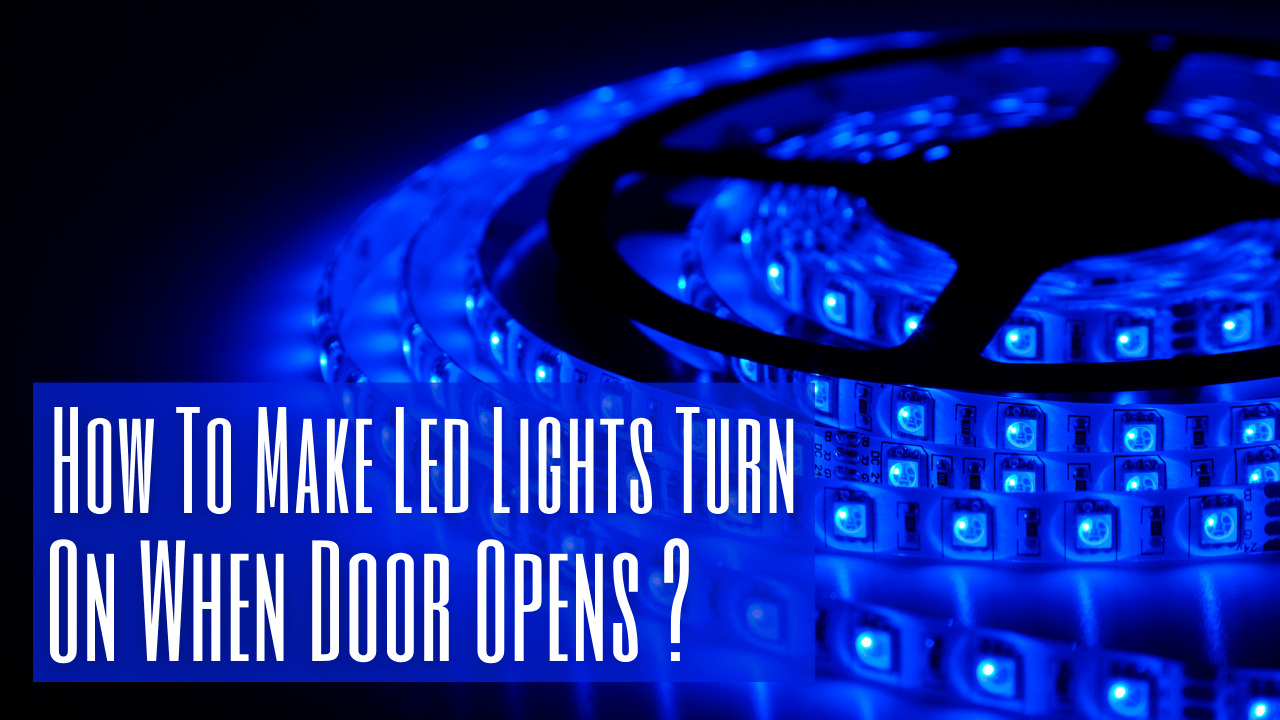Lights are among the most often used appliances in your home. When you need to sit in a specific area, these are necessary. As a result, the user must constantly manually turn them on and off.
Controlling these can annoy people who like to move about a lot or are lazy. As you go into your home, the lights automatically turn on. This is a clear example of automation in action.
When you open your door and turn on your LED lights, you’re essentially automating your LED lights. We’ll show you how to accomplish it in a few different ways and explain how to do it in this article.
LED lights have lately been manufactured by companies, allowing you to operate your gadget from a distance. You can even use a hub to connect them to your phone.
Table of Contents
Ways To Turn On LED Lights On When Door Opens
There are numerous techniques to execute this task, depending on the budget, skill, and equipment available. Some may be wealthy enough to acquire high-end sensors and equipment, while others may want to learn a simple and inexpensive approach. At times, you might consider installing automated lighting.
These will turn on when you enter your room and then turn off when you leave. People may choose to have these lights installed in their closets or wardrobes. This makes it simple to find items within them without the inconvenience of manually regulating your lights. To accomplish this, there are primarily two options.
The first is to buy a closet with this feature already fitted. This eliminates the need for you to place equipment in your wardrobe. Furthermore, this is the finest option for those who do not wish to become involved in technical matters.
You may look up some of the best-rated automated lighting closets online. After that, buy the one with the highest rating and begin using it immediately.
Install A Sensor-Based System
You’ll need a door open or close sensor, typically in the form of a wire with input and output ports and sensors, to use this method. A connector to connect the sensor’s ports with the power supply and LED may also be required.
- Identify the input and output ports on a door-open sensor.
- With the help of the connection, connect the input port to the power supply and the output port to the LED.
- Fasten the sensor probe/probes to the edge of the door frame such that when the door closes, the probe almost touches the door.
- Fix all wires appropriately.
- Open and close the results to inspect the installed system
With the help of this installed sensor-based system, you can turn off the lights when the door closes. Similarly, the lights will turn on when you open the doors.
Install Stick Switches
Install a little switch at the door opening of your closet. This can be immediately attached to your closet’s door or frame. Ensure that it is installed in conjunction with the hinges or edges. Once the doors to your closet have been opened, these stick switches will point out of the room.
They should turn on the lights that are attached to them as well. The closet can then be used after the doors are closed. The door will press against your stick switch. This sends data to your connection immediately and then disconnects it. The lights will be turned off for you as a result of this.
Use Push Buttons
With this method, you’ll need to make electrical connections using an LED bulb, a push-button, and two switches. To use this approach, follow the instructions below:
- Build a connection between switches
- Connect the terminals of connection with switches and build a connection
- Connect the two terminals with push buttons
- Connect the common connection wire with an LED light bulb fixture
- Now, connect the other bulb’s fixture terminal with the supply wire
- Affix the push button. So, it can automatically get pushed by the gate when you open it.
Hiring an electrician for this installation would be great, especially if you don’t know about wiring and connections.
Always Choose A Safe And Suitable Method
There are many other options, some of which are broad but difficult to implement. If you’re going to do it yourself, use a safe and quick method. Also, remember that the components are readily available in your area.
Consider safety precautions while doing the surgery. When dealing with higher voltages, it’s best to seek the advice of an electrician. Before you begin, turn off the power supply. You don’t have to worry about such things if you do it on a smaller scale with batteries.
Benefits Of Automating LED Lights When Door Opens
Lighting a room or area by installing a system that turns on when a door opens is practical and economical. This can be accomplished by combining LED lighting with a door switch, such as a microswitch or a magnetic reed switch.
Gather the required supplies and equipment, such as the LED lights, a door switch, wire connections, cables, and a voltage tester, before beginning the installation process. To reduce the risk of electrical shock, make sure the power is turned off at the circuit breaker.
Save Energy
A simple approach to use less energy is to automate your LED lights. 10% of your monthly electricity costs may come from lights left on when no one is home. You may save a lot of energy by automating your lights only to turn when someone is home. The convenience that comes with automating your LED lights is another benefit.
Imagine returning to a brightly lit home instead of fumbling in the dark for your keys. Or consider using your smartphone to turn on all the lights in your home before you even open the door. This level of convenience can be provided by automating your LED lights.
Improve Security
Your home’s security can also be improved by automating your LED lighting. For instance, turning on the lights when someone enters a room can discourage trespassers and intruders. To create the illusion that someone is home even when no one is, you can program your lights to switch on and off while you are away randomly. This may serve to repel possible intruders and robbers even more.
Boost Your Mood
Your mood and general well-being can both be enhanced by the correct lighting. Studies have demonstrated that exposure to specific forms of light can improve mood, focus, and energy levels. You may ensure you always receive the kind of light best for you by automating your LED lights.
No Need For Wiring
The lower risk of fire when automating your LED lights is another benefit. Faulty wiring is one of the main causes of home fires. No wiring is required if your lights are automated. This can significantly lower the possibility of a home fire starting.
The lifespan of your LED lights can also be extended by automating them. By automating your lights, you may avoid the damage that comes with manually turning them on and off. This can help your LED lights last longer and ultimately save you money.
What Types Of LED Lights Are Suitable For Automating Systems?
Flat And Small LED Lights
One of the most well-liked categories of LED lighting is puck lighting. They come in various lumen outputs and are small, flat, round, and circular. Puck lights have numerous applications, including under cabinets, accents, and tasks. Additionally, you may purchase puck lights with a range of base configurations, including screw-in, adhesive, and plug-in.
LED Strip Lights
Although strip and tape lights are similar, the latter has no adhesive backing. Strip lighting is excellent for accent lighting, coves, under cabinets, and many other uses. They are in strip form, allowing easy trimming to fit any location.
Try attaching strip lights to your selected surface with command strips or velcro if you want to utilize them but don’t want to deal with the adhesive.
Sensor LED Lights
Lighting automation is made easy with the use of motion sensor lights. When motion is detected, these lights will automatically come on and then turn out after a predetermined period. Security, energy efficiency, and convenience are all greatly enhanced with motion sensor lighting. Many types of motion sensor lights are available, including flood lights, wall sconces, and more.
Battery-Operated LED Lights
If you want the mobility to move your lights about without worrying about finding an outlet, battery-operated lights are perfect. Puck lights, strip lights, and other designs are only a few of the many kinds available for these lights. It is simple to turn on and off many battery-operated lights because they also feature timers or remote controls.
Final Thoughts
These options should be ideal for you, and you can easily choose. Keep this in mind. However, motion sensors are sometimes a better option than a switch. This is because all of these scenarios necessitate some wiring. Some customers may find the wiring running along the edges of their closet unsightly.
Our tutorial will show you how to do it most easily and cost-effectively. You can save much money on a light sensor if you discover how to make LED lights switch on when the door opens your way.
Frequently Asked Questions (FAQs)
Can You Turn On LED Lights Automatically?
Your LED lights may intermittently turn on and off if the power supply to them is unreliable. A faulty power source, an overloaded circuit, or problems with your electrical wiring could all be at blame for this.
Can You Leave LED Light Turn On For A Long Span?
You’ll wind up saving a lot of money over time because of the long lifespan and energy-saving characteristics of an LED. So, certainly, LED lights can be left on continuously. LED lights are ideal for prolonged use, whether as strip lights or Christmas lights.
Can I Keep LED Lights Turn On While Sleeping?
Daytime exposure to white light might be beneficial, increasing mood and alertness. You can use a modest red light at night because red light has no impact on the circadian clock.





